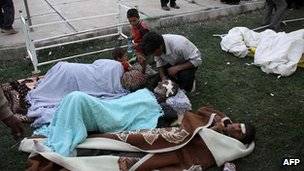Rescue teams in northwest Iran have been trying to dig survivors out of the rubble of villages leveled by two powerful earthquakes, northeast of the city of Tabriz, that have killed at least 250 people and injured more than 2,000.
Officials said emergency shelters were being distributed on Sunday and a field hospital was being set up in Varzaghan, one of the hardest hit towns, to treat the injured.
Residents in the region were terrified as their homes shook around them when the earthquakes hit, and fled into the streets for safety, according to reports.
Hundreds of people were rescued from under collapsed buildings on Saturday, but nightfall severely disrupted emergency efforts.
According to the official IRNA news agency, 66 rescue teams were at work, using 40 devices and seven dog squads to detect buried survivors.
"Unfortunately there are still a number of people trapped in the rubble but finding them is very difficult because of the darkness," the Fars news agency quoted the national emergency head Gholam Reza Masoumi as saying.
IRNA quoted Bahram Samadirad, a provincial official from the coroner's office, as saying: "Since some people are in a critical condition ... it is possible for the number of casualties to rise."
Blood bags
With telephone communications disrupted in the disaster zone, emergency teams were relying on radios and travelling in person to hard-hit villages to rescue and assess the destruction.
The earthquakes, which struck on Saturday within 11 minutes of each other, measured 6.2 and 6.0, according to Tehran University's Seismological Centre.
The US Geological Survey, which monitors seismic activity worldwide, ranked them as more powerful, at 6.4 and 6.3 on the moment magnitude scale, respectively.
Marzieh Vahid Dastejerdi, Iran’s health minister, said the government had dispatched 48 ambulances and 500 blood bags to the worst affected areas, IRNA reported.
Iran's Red Crescent took over a sports stadium to shelter 16,000 people left homeless or too afraid to return indoors, Fars reported.
It also provided 3,000 tents, blankets and tones of food - all a sign of years of preparedness in a nation prone to sometimes catastrophic seismic activity.
Villages decimated
President Mahmoud Ahmadinejad's office posted a statement on its website expressing condolences to those in the disaster zone and calling on authorities to "mobilise all efforts to help the affected populations".
Those hurt were taken to hospitals in Tabriz and Ardebil, another city nearby, both of which escaped relatively unscathed from the quakes.
In contrast, villages outlying the towns of Ahar and Varzaghan, 60km from Tabriz, were decimated, being closest to the epicenters of the two quakes.
Dwellings close to Heris, another town nearby, were also badly shaken.
Tehran University's Seismological Centre said the first earthquake occurred at 4:53pm local time (1223 GMT) at a depth of 10km.
The second, a big aftershock, rumbled through from nearly the same spot.
A series of more than 17 smaller aftershocks rating 4.7 or less rapidly followed.
The disaster zone was located about 90km from the borders with Armenia and Azerbaijan, and around 190km from the border with Turkey.
Iran sits astride several major fault lines and is prone to frequent earthquakes, some of which have been devastating.
Speaking to Al Jazeera, Ghanbar Naderi, a Tehran-based journalist, said that the earthquakes had created concern in the city "because the capital sits on three major fault lines and the last earthquake killed thousands of people".
The deadliest was a 6.6-magnitude quake which struck the southern city of Bam in December 2003, killing about 30,000 people and destroying the city's ancient mud-built citadel.
PHOTO CAPTION
At least 250 people have died and 1,800 have been injured in the quake, which leveled some villages and seriously damaged dozens of others.
Aljazeera


 Home
Home Discover Islam
Discover Islam Quran Recitations
Quran Recitations Lectures
Lectures
 Fatwa
Fatwa Articles
Articles Fiqh
Fiqh E-Books
E-Books Boys & Girls
Boys & Girls  Hajj Rulings
Hajj Rulings Hajj Fatwas
Hajj Fatwas














